

 The Accurate Reloading Forums
The Accurate Reloading Forums  THE ACCURATE RELOADING.COM FORUMS
THE ACCURATE RELOADING.COM FORUMS  Other Topics
Other Topics  Recipes for Hunters
Recipes for Hunters  First barbecue of the year 2014
First barbecue of the year 2014Go  | New  | Find  | Notify  | Tools  | Reply  |  |
| one of us |
Okay, the first honest-to-goodness barbecue of the year is happening today. We have two racks of baby backs and some country-style ribs with a Florida twist. Ribs were lightly brushed with yellow mustard, then dusted with a standard barbecue rub that I found rolling around in the back of the cupboard. Then they were thrown into the offset smoker over hickory smoke at a lower temperature (220 to 230) for a couple of hours to soak in the sweet smoky goodness. A water pan was used to control the temperature and to let the smoke penetrate into the pork better.Meanwhile, some bratwursts and a Spam blossom were thrown down for lunch. Now, as the water pan has just about evaporated down, I've just now bumped the heat up closer to 250 to 260, and am spritzing with a mop consisting of a little soy sauce, a little Meyer's dark rum and some Squirt. No foil. They should be close to done in a couple of hours; just before they come off the heat, I'll glaze with a wonderful combination of yellow mustard, brown sugar and pineapple juice (equal amounts). Tried and true ~ can't be beat! | ||
|
| one of us |
Whoops, change "pineapple" to orange! | |||
|
| one of us |
I'm glad you threw-out the pineapple, that sounded a little funky to me. So, when do you want us to come over? Something I've always been curious about is, what is the effect of Time. My rib thing used to be 200 degrees for four hours. Then I missed once. The ribs did not fall off the bone. Another half hour didn't help. Another hour didn't help. I gave up. I blamed it on the meat, but then I got to thinking that maybe once you hit the right combination of time & temperature, any additional time just dries the meat out, and no additional time or temperature can save the ribs. On the 200/4 combination that worked without fail, I left them foil-wrapped the whole time. On the 200/4 miss I left them unwrapped the first hour if I remember correctly. What's been your experience? | |||
|
| one of us |
Ken - I've got some thoughts on that ~ I'll try to post them as they get organised ~ In the meantime, here is a little bit of eye - candy from the smoke described above: On the grates, shortly before they were done: 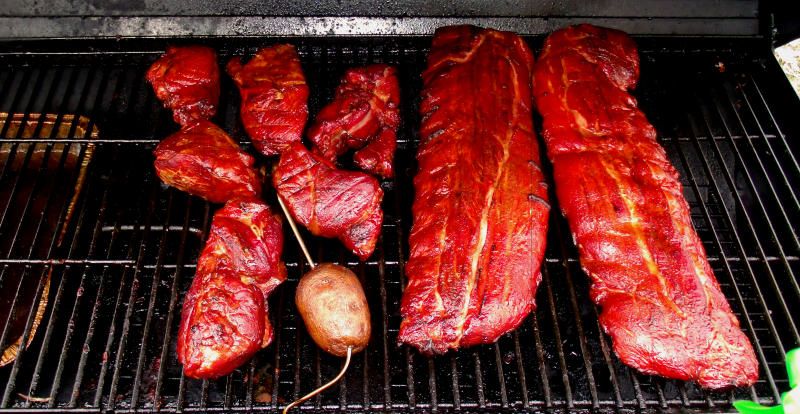 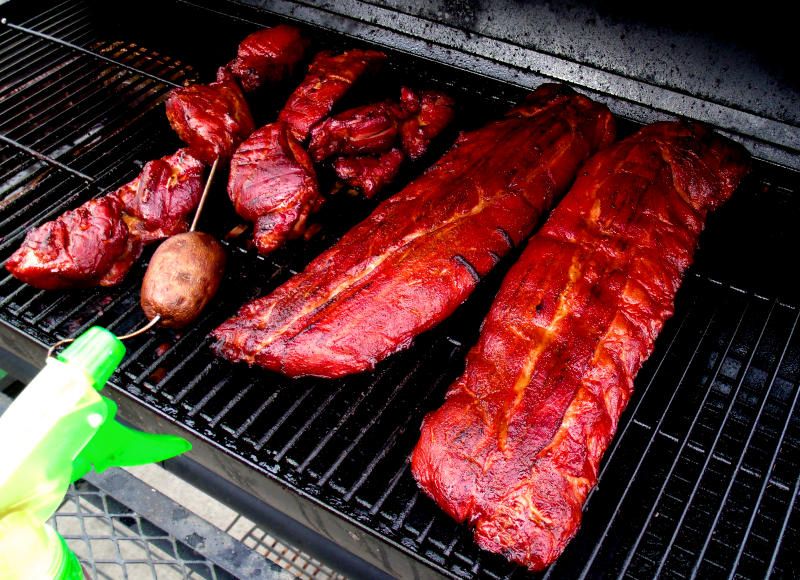 Looking pretty good, I'd say! 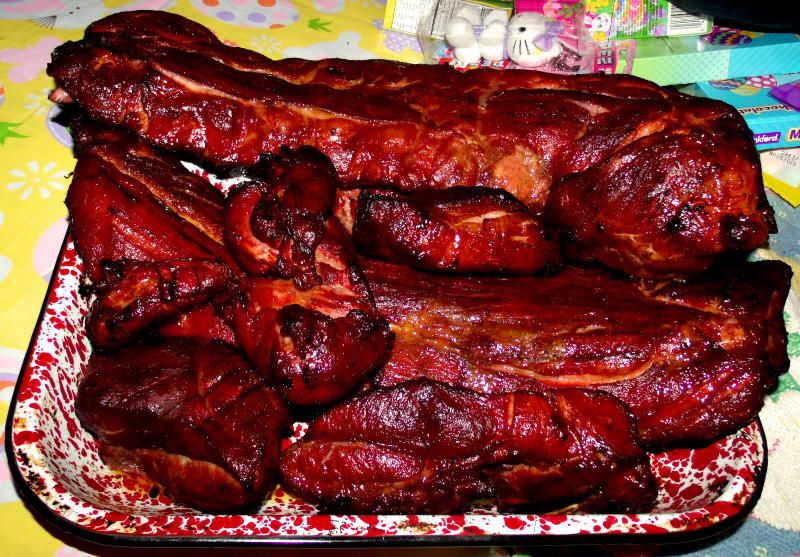 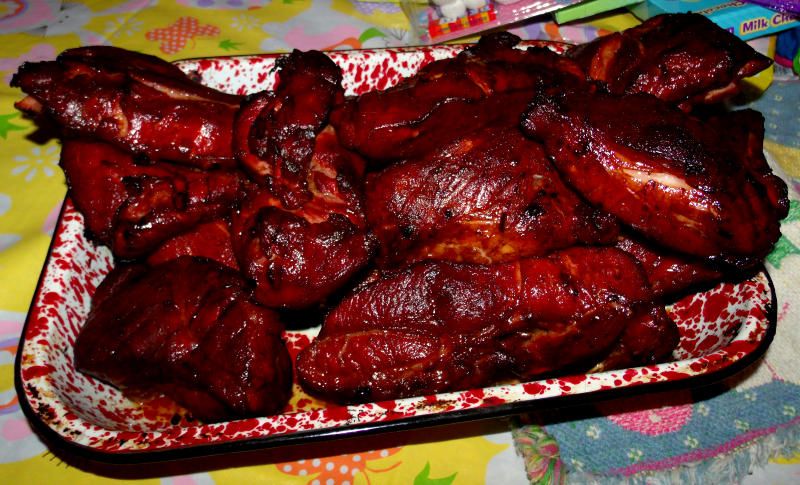 Nice smoke penetration, what I like to call "bacon on a sick...."  What'cha say? | |||
|
| One of Us |
I say you did good… | |||
|
| one of us |
Thanks, Heym ~
Ken - we always make extra when we barbecue - just bring a side-dish or a beverage, and drop on in! Regarding your comments above, I can offer what I've found through some experience. It works for me, and is definitely worth a try. For me, foiling ribs presents a few problems. One problem (relativeley minor) is smoke penetration. When I foil ribs, I never get the kind of penetration I am looking for. They come out tasting like they were baked in a covered glass dish in the oven. Another problem for me (relatively major) is that they "fall of the bone" TOO much when I foil them - to the point hwere I cannot turn them over without dropping bones. For me, it's too much - the texture of the meat is rather mushy when it gets to that point, and I just can't like them. Add that to the lack of smoke penetration described above, and it just doesn't work - for me. So for those reasons, I don't foil - or when I do, its only for an hour or so in the middle of the cook - with un-foiled time afterwards in order for them to "firm up" a bit. The cooking temperature of 200 - to me - seems way too low, and the ribs never have time in a 4 hour cook to really render the fat and collagen, leaving behind tender, juicy smoky goodness as they develop into good, barbecued ribs. They're foiled, so they are not too dry, but at the same time, It seems they just can't reach their "barbecue" properties within that time at that temperature under those circumstances. I've never tried them as you describe, so I could be off on my conclusions - but those are my thoughts. My suggestion is to give them a higher cooking temperature and try making them without the foil, or only a little foiling as described above. I prefer to start with temperatures on the low side (below 240) for the beginning stages of the cook, and then bring them up to the high side (24 to 25) later on. This accomplishes several things. The lower temps at the beginning promote development of the smoke penetration and flavour, including the smoke ring. The higher temps at the end promote bark formation and assure that the ribs are cooked well without being mushy or under-done on the inside (and also dry like jerky on the outside). For these same reasons, I also prefer to use a water pan early in the cook, and then finishing without one. My results are almost always dead-on; fat and connective tissues are rendered out and a really nice, roasted flavour develops as a result of "the Maillard effect." Ribs will not be mushy, but they will be nice and moist, with a little tug on the bone, rather than falling off the bone. Try this, and let me know what you think: The night before: 1. remove ribs from packaging; pat them dry with paper towels and place them on a rack and/or on a foil-lined cookie sheet or platter. 2. If they are spare ribs, trim off the bottom and side "brisket" and also the flap of meat on the back, leaving a rack of ribs and the trimmed brisket. This helps promote more even cooking and simply looks nicer as well. If you're cooking baby backs, no cutting is required. 3. With both baby backs and spares, be sure to also trim the white membrane off of the "back side" of the ribs. This might be a chore, but it is absolutely 100% worth it in the end. In theory, it peels right off, but in reality, there is often a little more work involved than that. 4. Brush with a light coating of plain, yellow mustard to both sides. Yes, I know, but you will NOT taste the mustard when the ribs are done, so no worries. Trust me on this, I know it sounds weird but it helps with rub absorption and bark formation. I've tried other mediums such as olive oil, catsup, vinegar, orange juice, butter and others; nothing works as well as plain, old yellow mustard, and there is never a "mustardy" taste. It took a leap of faith for me to try this, but I am glad I did. 5. Apply barbecue rub of your choice to both sides - be on the generous side, but not TOO much. If you're looking for a rub, let me know; you can make your own or buy a one. The main thing is that any rub you like is the right one to use. 6. Cover the ribs with saran wrap and place them in the refrigerator overnight. Doing this prep work the night before has led to better ribs every time. If you do the work right before cooking, your ribs will be fine, but they will be better if you take the time the night before. The next day: 1. Get your smoking wood (sticks, chunks, chips, pellets, whatever) and your fuel (charcoal, wood, whatever) lined up and ready for the day. Also a bucket and small gardening shovel to keep the firebox free of excess ash, if applicable. Tongs, gloves and anything else you might need? Set it up, now. If your smoker is set up for (or can accommodate) a water pan, start heating the water now up to boiling. 2. The hard work is done! Put on some music, set out a full cooler and some chairs. Crack open a beer or other beverage of your choice. 3. Depending on what type of pit you're using, light it up and get it to a steady temperature of at least 212 degrees (note the significance of that particular temperature - it does make a difference). Never use charcoal fluid or any other "starter." A charcoal chimney is cheap and effective, and you won't have to wonder what chemicals are getting onto your food. 4. While the pit is heating up, it's a good time to see if anything else needs done - or, take a look at your smoker for anything it needs in terms of maintenance, and then either act on it or make note of it for future reference. One thing I like to do is see if I am getting any rust anywhere on the pit; if so, give the rusty area a quick brushing with a wire brush and then spray a little Pam (or similar cooking spray); you can of course rub down with a little cooking oil, lard or whatever. Wipe off the excess with a paper towel. As the pit heats up, it bakes the fat into the surface of the pit, seasoning it like a cast iron pan, stopping rust and turning black for a nice finish. 5. If you're using a water pan, fill it up now with the boiling (or almost boiling) water when the pit gets to 212. The temperature will probably drop again for a few minutes, but will go back up. Now is also a good time to add your smoking wood. You only need a little - just enough to maintain a thin, blue stream of smoke that you can barely see. If the smoke is black, dark grey, billowing white or heavy, you're doing something wrong - you probably need to get more oxygen on the fire and improve airflow. 6. Once the pit crosses 212, remove your meat from the refrigerator and apply a little more rub, if you'd like. Put the meat on the grates. 7. Close the lid and keep it closed. Try to disturb the ribs as little as possible for at least an hour; maybe 90 minutes. Maintain a temperature of around 225 for an hour or two, allowing the smoke to penetrate into the ribs and for the rub to set. 8. Temperature control: Keep the exhaust vent/smokestack fully open at all times. You can control the temperature with the intake, shuttering it open to raise the temperature and closing it off a bit to lower the temperature if needed. Do not close it all the way. If the pit over-heats, simply open up the firebox (or in extreme cases, crack open the smoking chamber a bit) to dump the extra heat. Try to keep the cooking temperatures between 225 and 235 at this stage. Add fuel if you need to in order to maintain temperature; it pays to shove the existing fuel to one side and set the new fuel near - but not touching - the existing fuel. This is also a good practice when adding smoking wood. Preheating the fuel and/or smoking wood in this way does a lot to maintain a good temperature curve and especially promote clean, efficient burning of fuel and wood for best results. 9. After 90 minutes or so, I like to apply a "mop," also referred to as a "spritz." This can be as simple as plain old apple or orange juice, or more elaborate. Pretty much any combination you like is good, as long as it is relatively thin and moist. It is also very good to have a bit of oil or fat (I use olive oil) in there. I don't know exactly why, but my ribs are better when it's there, so I do it. I think it has to do with a basting effect. A combination that I've found to work very well for ribs involves a mixture of Dr. Pepper (about 1 cup, maybe 1-and-a-quarter), low-sodium soy sauce (about 1/2 cup) and a little olive oil (about 1/4 cup); I've also used many variations on this with different beverages and sauces, depending on the desired effect - but the basic one never fails. mix the mop well, apply the mop to the ribs, then flip them over and rotate them to promote even cooking. Apply mop to the other side. I like to apply the mop every hour or so, which is also usually a good time to add fuel, a chunk of smoking wood or whatever. Be sure to flip and rotate the ribs, while you're at it. 10. After the first couple of hours, bump the temperature up to around 250 degrees, although if it is 10 degrees on either side of this, it's no big deal. Maintain this temperature range throughout the cook until you're close to the very end. Allow the water pan to evaporate down to nothing - no need to add more water as in my experience the benefits happen during the early stages and there are diminishing returns as the cook gets toward the end. 11. Baby backs will usually take around four hours; spares around five; depending on temperature control issues, I always assume that they will take an hour or so longer than that, too. Toward the end, when you judge that you are maybe an hour from being done, you can, if you want, start applying a glaze in a few very thin layers. My "go-to" glaze that I recommend consists of equal parts brown sugar, yellow mustard and apple cider vinegar. Once again, I know that it sounds weird, but it works and works well, taking three weird flavours and making a whole new one. Take 1/3 of a cup of each, and heat them on the stove on medium until everything is dissolved and mixed well, then set aside and allow to cool. As with my "basic" mop recipe above, it can be modified to fit the occasion, using different things such as orange or pineapple juice, catsup etc. - but the basic one never fails. When the time comes to start applying it, use a brush and apply in a very thin layer to both sides of the ribs. Allow the glaze to "cook in" for 20 minutes or so, then repeat. Four or five applications should be enough, but if you want more, then go for it. This glaze will make good ribs better, and will also give the ribs a beautiful, mahogany sheen. Apply the last coating of glaze just a minute or two before the ribs come off the heat, if you want them to be a little wet, or 10 minutes or so before, if you want them to be dry. 12. The ribs are ready! I honestly don't know how I know when they are ready, but it's usually just a while after I THINK they are ready. Knowing when they are ready is a bit difficult; meat that is "done" and meat that is "barbecue" are two different things, as barbecue involves higher finished temperatures necessitated by the time and temperatures required to render fat and melt connective tissues. This is the reason barbecue is done "low and slow" rather than "hot and fast" as is done with grilling lean cuts such as steaks, chops etc. I see no point in trying to do a probe temperature reading on ribs due to the thin meat, but as I recall one source says that an internal temperature of 172 represents great ribs. If you use a thermometer, that's a good temperature to try - maybe 180, probably no higher than 185. Some people measure readiness by "pullback" of the meat from the bones, and this is as good as any way that I've found to determine when to remove the meat from the heat. Mainly, they simply look and feel ready. Experience is the best teacher. 13. Remove the ribs from the heat to a platter, cover them with foil to keep them arm and allow them to rest for a few minutes while you get out the paper plates, napkins etc. 14. Cut the ribs into serving portions as you desire, serve and enjoy. Sauce is almost never necessary, but it's okay to set some out for those who don't know any better. Important things to remember: a) Maintain good airflow throughout the cook. Lack of airflow leads to bitter, ashtray-tasting meat due to condensation and the formation of creosote. b) Maintain temperature and your fire as consistently as possible. The best fire is a small, efficient fire based on coals rather than flames; too big or two small, and you have problems. Learn to think ahead when it comes to adding fuel to the firebox. c) You do not need as much smoke as you probably think you do. As long as you have an almost-invisible, clear, blue-grey smoke, you are in great shape. Any change in this condition means you need to set the beer down and look at your fire or airflow. Billowing, white smoke might look impressive as the neighbours drive by to see what's going on, but for smoking meat, it isn't any good, either. d) Experimentation leads to great things! Try some different things and see how you like the results. 19 times out of 20, even the "screw-ups" will be better than anything you can buy downtown. That is a good, general over-view, any questions, just ask. The higher (but not too high) cooking temperatures sould result in some very good things - at least worth one try. | |||
|
| one of us |
Thanks T, excellent tutorial. I'll give this road map a go next time I'm cooking. I am thinking of trying beef short ribs next time. Should I treat them just like spare ribs, or are there any modifications to the process that you would suggest? | |||
|
| one of us |
Beef shortribs are outstanding ~ I really love them, but haven't done too many of them. A couple of ideas: Keep your "rub" or seasoning simple. Beef doesn't need much! sea or kosher salt, cracked black pepper, garlic, onion, maybe a little red pepper flake and/or coffe. Good paprika somewhere in there is also a good idea. Not much else needed. The mustard brush-on is still a good idea, but for beef it might be worth it to try Dijon mustard.... Beef short ribs will "probably" be done earlier than pork ribs. There won't be as deep a smoke ring, but it will probably be pretty intensely-coloured. For a mop/baste, it's hard to beat a Basque/Spanish technique called "kalimotxo." Really simple: just a 50/50 mix of dry red wine and Coca Cola. mix these together, maybe add a little olive oil, and brush it on during cooking, after an hour or so. repeat every 45 minutes or so and it will glaze on pretty well. If you're intersted in this, I've got some notes here from one I did a while ago:
| |||
|
| one of us |
After reading that, I'm full, couldn't eat another bite, gained a pound at least. What I see in your photos is the "holy grail". It certainly sets the bar high. It's definitely made me want to try beef short ribs next cookout. | |||
|
| one of us |
Give 'em a try! My parents split a home-grown beef with us and we just recently got the meat in the freezer. Naturally there were some ribs and short ribs in there, and I intend to be enjoying them pretty soon ! I appreciate the kind words - almost everything I've posted up there is because someone passed along a few fundamentals to me; from there, I kind of took things in my own direction, but the fundamentals remain. Hopefully, I can do half as good a job of passing them along. If you (or anyone) ever has any questions, let me know. If I am slow to respond here, I can be found at http://foodsoftheworld.activeboards.net! | |||
|
| one of us |
If they taste half as good as they look, you need to open a Q joint. I'm sure Montana needs a good one. xxxxxxxxxx When considering US based operations of guides/outfitters, check and see if they are NRA members. If not, why support someone who doesn't support us? Consider spending your money elsewhere. NEVER, EVER book a hunt with BLAIR WORLDWIDE HUNTING or JEFF BLAIR. I have come to understand that in hunting, the goal is not the goal but the process. | |||
|
| one of us |
Tas , I could give you some numbers and times for heat treating knives , then you could write it up.Would sound better than mine !! They are about to open a BBQ here in town .I have no expertese in that .If it's terrible I'll give them your name. | |||
|
| one of us |
Many thanks, gents ~ Gato, you are tight, Montana could use a good one, and I have considered it! Mete, I don't have too many natural talents, but one is that I can write about ALMOST anything, as long as I know a few things about the fundamentals of it! | |||
|
| one of us |
The good thing about good Q is that the pitmaster doesn't have to start with a full scale restaurant. You can sell from you car or truck with a sign by the highway. Having your smoker there with smoke coming out is a good touch. If the Q is good, it will be obvious that your product can scale up and you will have both repeat customers and new word of mouth customers. There are people in several places that have never gotten beyond a trailer parked on the side of the road that are making a good living from Q. While Hwy 2 is not an interstate it has a lot of traffic, or you might consider closer to Havre. Maybe you know a gas station owner who would let you sell near or on his place. It always helps if the potential buyer is stopping anyway. If you want to do it, I'd start small and see how it goes. Just as an example cook maybe 20 pounds of brisket and 20 pounds of ribs for a Saturday afternoon. Consider sandwiches and then you might cook a shoulder for pulled pork. Of course, check for health dept rules. If you don't sell it all, you can freeze it for home use. Be aware that good Q cooking takes time and that means time from other activities. xxxxxxxxxx When considering US based operations of guides/outfitters, check and see if they are NRA members. If not, why support someone who doesn't support us? Consider spending your money elsewhere. NEVER, EVER book a hunt with BLAIR WORLDWIDE HUNTING or JEFF BLAIR. I have come to understand that in hunting, the goal is not the goal but the process. | |||
|
| One of Us |
Your ribs, along with pretty much every other recipe you post here, look awesome! This Saturday is my second annual pig roast in Cheyenne. Here are some pictures of last year's guest of honor. 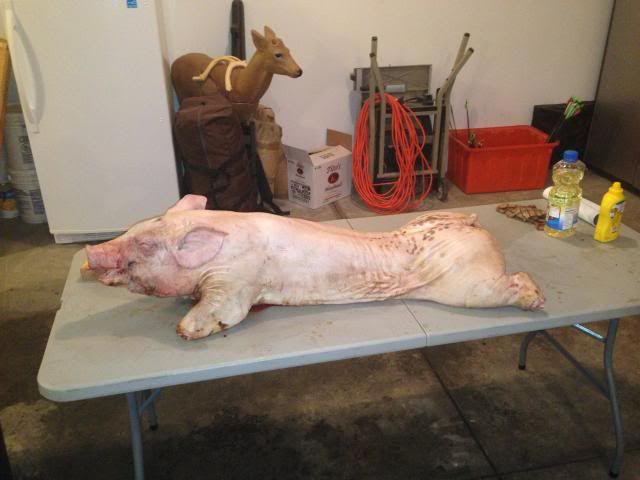 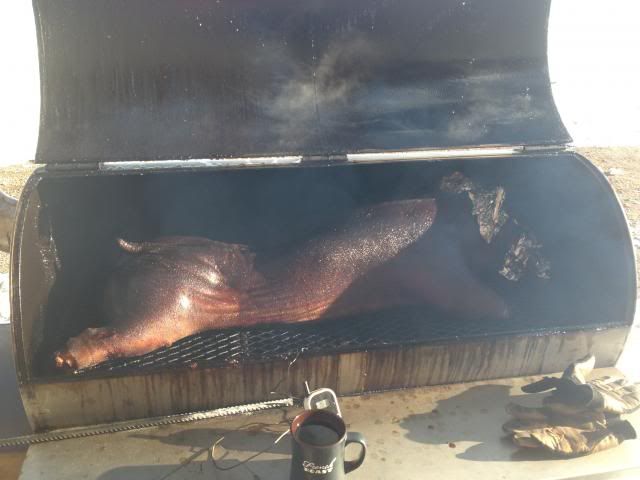 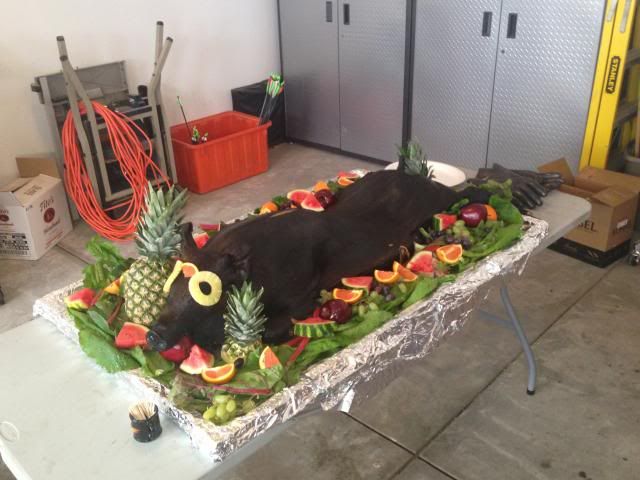 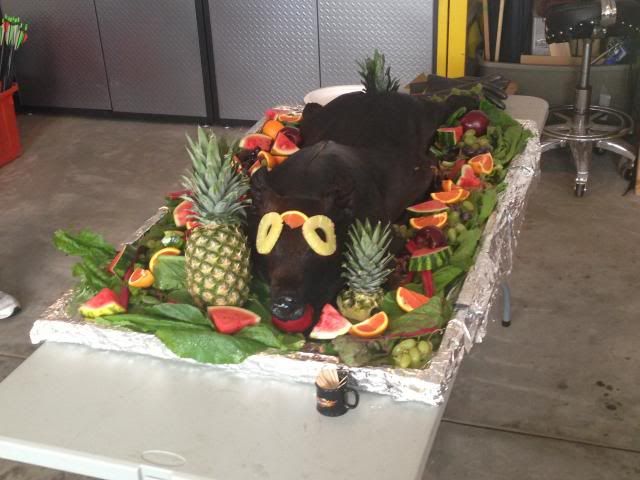 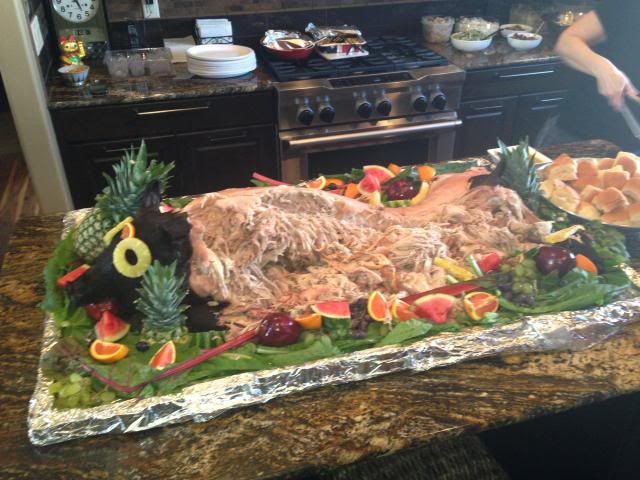 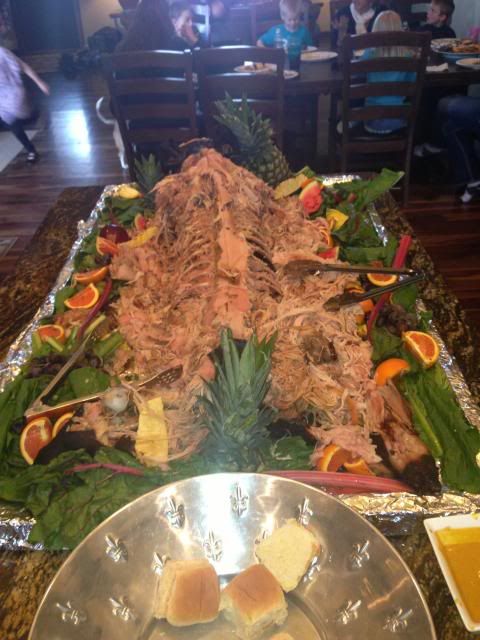 ____________________________________________ "Build a man a fire, and he'll be warm for a day. Set a man on fire, and he'll be warm for the rest of his life." Terry Pratchett. | |||
|
| one of us |
I'm going for your Short Rib Kalimotxo Barbecue recipe this weekend, and possibly the two weekends following that if we like the initial test. (Three different groups of family/friends, so only the wife and I will notice the repetition.) I'm going to buy the ribs Thursday, and may prep and Saran Wrap Thursday night for cooking Saturday evening. (Is 48 hours, too much?) The mustard I'm going to use is a honey mustard pretzel dip. The only excuse I can give is; because it's in the fridge, and will probably go to waste otherwise. The wine I'm going to use for the Kalimotxo is a cheap Wal-Mart red blend that we found by accident, that we really like. (Apothic Red 2012, California; Zinfandel, Merlot, Syrah, Cab Sav blend. It should cost $20+, but goes for like $7.00. We're not into Dry wine, and this is very smooth.) I'll be using an offset wood fire. I'll try to keep the heat around 230F in the cooking chamber for the first two hours, and use a water pan. I'm thinking of going without a paper or foil wrap for this recipe. For the next two hours I'll move the heat up to around 250F. At some point I thought I would replace the water pan in the cooking chamber with the pan holding the Kalimoxto mix and when the reduction looks right start layering as you described. From there I guess I'll just play it by ear, or eye, until it looks finished, then move it off to rest and hope for the best. If you see anything above that appears to represent a train-wreck in the making, I would appreciate a heads-up please. | |||
|
| one of us |
Ken - sounds like a great plan to me - the only thing I am not totally sure of this the keeping the kalimotxo in the cooking chamber; I've never done it before, so I can't comment on it. I know that water in the water pans start looking pretty "brown" before too long because of the smoke, but this could be a non-issue. If yu've done it before with similar bastes or sauces and have had good results, it should work great. The mustard should be fine, and the wine sounds really nice! Keep in touch, and let me know how it goes ~ Lhook - looks great! One of these days, I'll try a whole pork it's one of those things that I think would be a heck of a good time. Gato - your thoughts on the subject are pretty close to the ones I've been thinking as well. I've got some long-time friends who have asked if I can do a whole bunch of pulled pork for a graduation party, and I'll see how their reaction is. | |||
|
| one of us |
Everything is prepped and in the fridge, but I've got a question. My intent was to throw a couple of sausages on the smoker while I'm cooking the short ribs. Most of what I read says cook sausages fast, don't slow cook unless they have a "cure". I don't recall ever slow-cooking sausages, but don't understand why that wouldn't be safe if you cooked them thoroughly. Am I missing something? The sausages are fresh and go by the name of Argentinian Bacon Sausage. I've never heard of them before. I'm going to call back to the meat market today and ask what makes them "Argentinian". | |||
|
| one of us |
If they are fresh, and have no cure, then that means they should be cooked relatively "fast," meaning that they can't be cold-smoked over the course of several hours at themperatures in the 40-140 range. with your cooking temperatures much higher, i wouldn't worry about this. What I would do is toss them on the smoker at the "warmer" end and simply cook them, however long it takes (probably no more than a couple of hours) until they're done. If you're keeping track of internal temperatures, the fresh sausages should get to 165 degrees ~ | |||
|
| one of us |
That should be a good test. The feedback you get, both good and bad (if any) should guide you towards a "feel" for local tastes. As an example, I like spicy hot and many others don't, they prefer sweet or simple smoke. You'll have to make a choice but don't be so middle of the road that it becomes ordinary blah tasting. As it develops, you might even have 2 varieties, but not to start. Don't under- or over-price your product. Personally I think pulled pork, served at a locale (meaning you've got to take it there and present it) should be at least $10/pound. If they won't pay that, then you should tell them you like 'em, but aren't in the business of working for free. In Texas at generally good Q joints, I see pulled pork from about $8.50 to $13/lb or even more, and, of course, beef and pork prices are going up rapidly (as if we hadn't noticed). xxxxxxxxxx When considering US based operations of guides/outfitters, check and see if they are NRA members. If not, why support someone who doesn't support us? Consider spending your money elsewhere. NEVER, EVER book a hunt with BLAIR WORLDWIDE HUNTING or JEFF BLAIR. I have come to understand that in hunting, the goal is not the goal but the process. | |||
|
| one of us |
Cooked the beef short ribs yesterday, per your recipe. They turned-out pretty well in the tenderness department. I had trouble stabilizing the temperature initially since my grill/smoker is an offset stick burner. I checked the short ribs after 90 minutes and was surprised how dark the color was; not reddish as much as blackish. Maybe my temperature got a little too hot. Any thoughts? I was trying to hold it at 225, and as long as I stared at it, it played nice. As soon as I turned my back on it, or walked away, it would start doing its own thing, usually to the upside. At the two hour mark I decided not to bring the temperature up to 250. It was just looking too done on the outside. (I put the sausage on at this point.) I also dumped my water pan at this point and put the Kalimoxto mix in the pan and put it back in the cooking chamber. An hour later, hour three, I flipped the sausage. I then dipped the short ribs in the K-mix, and held the temperature at 225 for the remainder of the cook. I dipped in the K-mix at 30 minute intervals twice more, let the meat have a final 15 minutes on the smoker at 225, and then moved it off to rest. The color wasn't the reddish mahogany outside as I said, but the meat looked great inside, nice smoke ring, and tender. Whether using tools or fingers, the meat came off the bone without much effort. The sausage was good, but after cutting the links, I left them in the smoker another thirty minutes while we worked on the short ribs and wine. (Next time I'm going to leave the fresh sausage on for three hours instead of two.) I found it interesting that the meat market labeled the sausage as Argentinian Bacon Sausage although as near as I can tell the recipe had nothing to do with Argentina. When asked, they told me they made the recipe for Fogo de Chao restaurant here in Dallas. (FdC is a Brazilian-style restaurant.) My guess is that they know meats, but not geography. Next weekend I'm switching from beef short ribs to pork spare ribs, but other than that, I think I'm staying with the same recipe. (By the way, the mustard layer followed by the rub and 48 hour wrap, worked great.) I may forego the water pan, and go with the K-mix in the pan from the get-go. If that sounds crazy, let me know. | |||
|
| One of Us |
| |||
|
| one of us |
hey, guys - sorry it took so long for me to reply. Gato - in the case of the graduation pulled pork, I agreed to do it for the cost of the stuf. The family really enjoyed it, and even though the costs were only about 85$, they insisted that I accept 100$ in return; not too bad, but if I were actually charging for it, I'd defnitely be asking for more, because of the reasons you mention. Ken - temperature control is always a challenge. I'm going to guess that the "blackish" colour on your ribs might have come from too much direct (versus indirect) heat - or possibly if you had any sugar in the rub, it might have burned. Thoseare just guesses, but if the ribs were too close to the "hot side" of the cooking chamber, this might explain it. I like the idea of dipping in the kalimotxo - I'll be trying that next time! | |||
|
| Powered by Social Strata |
| Please Wait. Your request is being processed... |
|
 The Accurate Reloading Forums
The Accurate Reloading Forums  THE ACCURATE RELOADING.COM FORUMS
THE ACCURATE RELOADING.COM FORUMS  Other Topics
Other Topics  Recipes for Hunters
Recipes for Hunters  First barbecue of the year 2014
First barbecue of the year 2014

Visit our on-line store for AR Memorabilia

